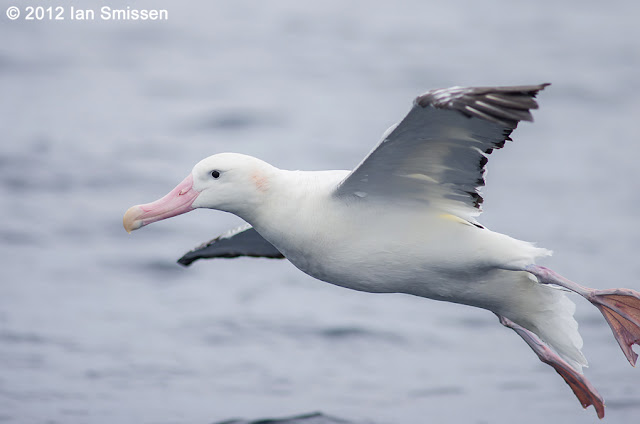One of my long-standing birding ambitions has been to go on a pelagic trip so when one was being organised by the Melbourne Photography Group of
BirdLife Australia through
Birdswing Birding & Wildlife Tours, I jumped at the chance and was not disappointed.
15 hardy souls assembled with cameras, binoculars and warm and weather proof clothing at Port Fairy wharf at 7:15 for a 7:30 boarding of the
Perceive.
 |
Perceive docked at Port Fairy wharf
(at the end of the trip - I was too busy chatting to get the early morning photograph) |
Once all were aboard we headed down the Moyne River into Port Fairy Bay, rounded Griffith Island and headed SW into the rolling swell of the Southern Ocean. The sky was heavily overcast but there was almost no wind which made for fairly pleasant travel albeit with lots of up and down (I have never suffered from sea-sickness but took the precautionary pharmaceutical prophylactic before hand just in case...thankfully, I have still never suffered from sea-sickness).
We cruised for 2-3 hours out past the continental shelf, stopping when there were birds to be seen, burleying to attract the birds in closer to the boat. For some reason, few were keen to "land" on the water (an interesting, oxymoronic expression) for a feed but many were happy to fly around the boat.
First to fly by were several
Shy Albatross (at one stage we counted at least 10)
 |
| Shy Albatross, Southern Ocean |
including this immature bird
 |
| Shy Albatross (immature), Southern Ocean |
and one alighted close enough for some good close-ups
 |
| Shy Albatross, Southern Ocean |
Among the Shy Albatross, there were also several
White-chinned Petrels (my first lifetime tick for the day)
 |
| White-chinned Petrel, Southern Ocean |
We were also lucky enough to see a lone Campbell Albatross. I believe that the discussion about the taxonomic status of this bird continues re whether it is elevated to its own species or remains a race of the Black-browed Albatross. Regardless, it was a pleasure to see it and clearly identify it by its "honey-coloured eye" (the poetic description courtesy of Pizzey & Knight).
 |
| Campbell Albatross, Southern Ocean |
Next stop there were more Shy Albatross and White-chinned Petrels but the highlight was this
Wandering Albatross that cruised gracefully around the boat
 |
| Wandering Albatross, Southern Ocean |
before alighting (more like a crash landing - it's amazing how graceful these birds are in flight and how clumsy they are landing and taking off)
 |
| Wandering Albatross, Southern Ocean |
settling for several minutes within a few metres of the boat
 |
| Wandering Albatross, Southern Ocean |
closely followed by several Great-winged Petrels (far more graceful - taking off like ballet dancers).
 |
| Great-winged Petrel, Southern Ocean |
This immature Black-browed Albatross spent a long time circling and following the boat.
 |
| Black-browed Albatross (immature), Southern Ocean |
We also spotted several smaller seabirds including Fairy Prion and Wilson's Storm-Petrel but they remained too far away for good photographs. However, this Grey-backed Storm-Petrel (another life-time tick for me) came close enough for a few ID shots.
 |
| Grey-backed Storm-Petrel, Southern Ocean |
All too quickly, time caught up with us and we headed back into Port Fairy - 3 hours cruising but much easier surfing the swell than climbing into it on the way out.
One last gem awaited us right at the entrance to the Bay - difficult to shoot backlit by the (now) bright afternoon sun but worth including as another lifetime tick for me making three for the day.
 |
| Northern Giant-Petrel, Port Fairy |
Thanks to Neil of Birdswing Birding & Wildlife Tours for his guiding, Russell and Paul for their skipper and mate duties on board the
Perceive and John for organising our participation.



























































